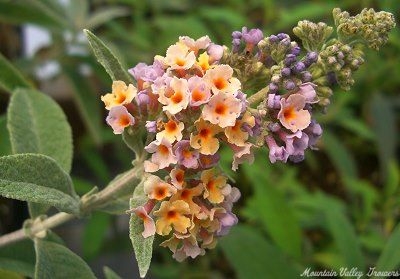Buddleja: The Butterfly Bush That's
Buddleja: The Butterfly Bush That's More Than Just a Pretty Face
Butterfly bushes (Buddleja davidii) are some of the most popular shrubs in gardens around the world. With their long, showy flowers that attract butterflies in droves, they're sure to add a touch of beauty and whimsy to any outdoor space.
But butterfly bushes are more than just pretty flowers. They're also relatively easy to care for, drought-tolerant, and can even help to improve air quality. In this blog post, we'll take a closer look at the butterfly bush, exploring its history, cultivation, and benefits.
History of the Butterfly Bush
Buddleja davidii is native to China and Japan, where it has been cultivated for centuries. It was first introduced to Europe in the early 19th century, and quickly became a popular ornamental plant. In the United States, butterfly bushes were first planted in the 1860s, and they've been enjoyed by gardeners ever since.
The name "butterfly bush" comes from the fact that these plants are extremely attractive to butterflies. The flowers produce a sweet nectar that butterflies love, and the bushes' long, slender branches provide them with a place to perch and rest. In fact, butterfly bushes are often used in butterfly gardens to attract these beautiful creatures.
Cultivating Butterfly Bushes
Butterfly bushes are relatively easy to care for. They prefer full sun and well-drained soil, but they can tolerate some shade. They're also drought-tolerant once established, and they don't need to be fertilized very often.
Butterfly bushes can be pruned in the spring to shape them or to control their size. They can also be propagated from cuttings.
Benefits of Butterfly Bushes
In addition to being beautiful and attracting butterflies, butterfly bushes also offer a number of other benefits. For example, they can help to improve air quality. The flowers of butterfly bushes produce volatile organic compounds (VOCs), which have been shown to remove harmful pollutants from the air.
Butterfly bushes can also help to attract other pollinators, such as bees and hummingbirds. These pollinators are essential for our ecosystem, as they help to pollinate plants that we rely on for food.
Conclusion
Butterfly bushes are a beautiful and beneficial addition to any garden. They're easy to care for, drought-tolerant, and attract butterflies and other pollinators. If you're looking for a low-maintenance way to add some beauty and wildlife to your outdoor space, a butterfly bush is a great option.
Buddleia, also known as the butterfly bush, is a beautiful and fragrant shrub that is a favorite of butterflies and other pollinators. With its long, cascading flowers in a variety of colors, buddleia can add a touch of elegance to any garden.
If you are thinking about adding a buddleia to your garden, Garden Wiki is a great resource for more information. The website provides detailed information on buddleia varieties, planting and care instructions, and tips for attracting butterflies.
In addition to its beauty and usefulness, buddleia is also relatively easy to care for. It is drought-tolerant and can withstand a wide range of temperatures. With a little bit of care, buddleia can thrive for many years in your garden.
So if you are looking for a beautiful and easy-care shrub that will attract butterflies and other pollinators, buddleia is a great choice. Visit Garden Wiki today to learn more!
FAQ of buddleia
1. What is buddleia?
Buddleia, also known as butterfly bush, is a genus of flowering shrubs that are native to warm temperate and subtropical regions of the world. They are known for their long, colorful flower spikes that attract butterflies and other pollinators. Buddleias are relatively easy to care for and can grow in a variety of soil conditions. They are hardy in USDA zones 5-9.
2. How do I care for buddleia?
Buddleias prefer full sun and well-drained soil. They should be watered regularly, especially during the first year after planting. Buddleias can be pruned in late winter or early spring to shape the plant or remove dead or damaged branches. They are not typically susceptible to pests or diseases, but they may be affected by powdery mildew in humid climates.
3. How long does buddleia bloom?
Buddleias typically bloom from late spring to early fall. Some varieties, such as 'Pugster Blue', can bloom for an even longer period of time.
4. Do buddleia need to be pruned?
Buddleias do not need to be pruned heavily, but they may benefit from some light pruning in late winter or early spring. This will help to shape the plant and remove dead or damaged branches.
5. Are buddleia invasive?
Some varieties of buddleia can be invasive in certain areas. If you are concerned about invasive plants, it is important to choose a variety of buddleia that is not known to be invasive in your region.
Image of buddleia
5 different images of "buddleia" from Pinterest:
- Buddleia davidii, also known as butterfly bush, is a popular garden plant that attracts butterflies with its fragrant, colorful flowers.

- Buddleia alternifolia is a smaller species of butterfly bush that is native to China. It has white or pale lavender flowers.
- Buddleia globosa is a shrub native to South Africa. It has small, round, purple flowers.

- Buddleia x weyeriana is a hybrid butterfly bush that is a cross between Buddleia davidii and Buddleia alternifolia. It has large, lavender flowers.

- Buddleia nitida is a shrub native to China. It has small, white flowers that are fragrant at night.

Post a Comment for "Buddleja: The Butterfly Bush That's"